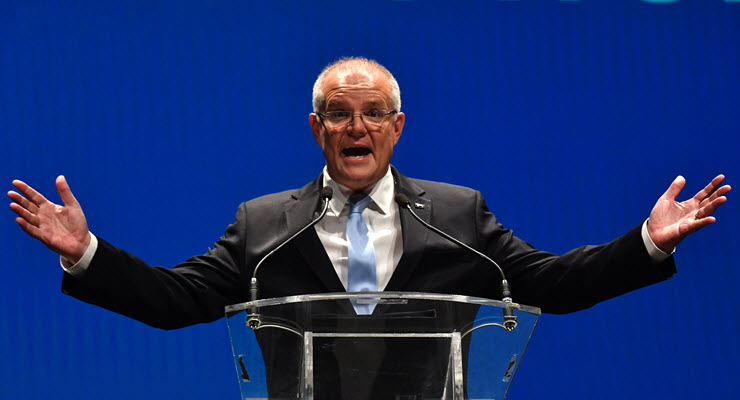
A month on from the election, the second phase of Scott Morrison’s triumph is unfolding with the Australian Electoral Commission’s finalisation of the immensely complex Senate preference distributions.
The Coalition went into the election with 31 senators out of 76 and comes out with 35 — and may be about to go one better if there is anything behind suggestions that Cory Bernardi is set to rejoin the Liberal Party.
That would leave the government needing the support of only three crossbenchers to win contested votes. That could be achieved with the two votes of the Centre Alliance plus that of Jacqui Lambie, who is newly restored to the Senate after falling victim to the Section 44 imbroglio in late 2017. Lambie appears to be co-operating closely with the Centre Alliance, having long enjoyed a warm relationship with the party’s founder Nick Xenophon.
Such a voting bloc would relieve the Morrison government of the need to dirty its hands in dealing with One Nation — though it could certainly do that any time the Centre Alliance members felt inspired to take liberal positions on such issues as asylum seekers and expansion of the national security state.
The Coalition owes its strengthened position in large part to one legacy of the Turnbull era that even the most paleo of Liberal Party conservatives have no cause to bemoan: Senate electoral reform.
Under the old regime of group voting tickets, the rise of the micro-party vote was making it increasingly difficult for the Coalition to score three Senate seats out of six in any given state. This was because micro-party preference harvesting worked on the principle that one of them was likely to get lucky if they all favoured each other ahead of the established parties, without regard to their ideological outlook.
As a result, the Coalition needed to get close to three quotas (just shy of 43%) off their own bat to win three seats.
With preferences now scattering all around and large shares accruing to the major parties on name recognition alone, near enough is effectively good enough. This is a fact reflected in the Coalition’s success in winning three seats in every state except Tasmania, where they were elbowed aside by Lambie.
Under the old system, the Coalition would certainly have fallen short of a third seat in Victoria and likely also in South Australia, and it would have been touch and go for them in New South Wales. That would have meant a bigger crossbench, and probably an expanded presence for One Nation.
In theory Labor should also have an easier time winning three seats under the new system, but such was their miserable share of the vote — 33.4% nationally in the House, and just 28.8% in the Senate — that they didn’t come within a lion’s roar of doing so.
It was a particularly demoralising result for Labor in Queensland, where the injury of their election-losing performance in the lower house has been compounded by the insult of their unprecedented failure to win a second seat in the Senate.
However, it hasn’t been one-way traffic for the Coalition — so far as the Senate is concerned, Labor’s loss has partly been the Greens’ gain, reflecting a much better election for the party than has generally been recognised. Most of the commentary on the Greens’ performance has focused on their static share of the lower house vote and failure to fulfil exaggerated expectations for the long-shot seats of Kooyong, Higgins and Macnamara.
It has been scarcely acknowledged that their share of the national Senate vote rose from 8.65% to 10.19%, which had as much bearing as the electoral reforms on their success in winning a seat in each state — something they had only managed previously in the blowout that followed Labor’s blood-letting in 2010, and in the special circumstance of the 2016 double dissolution.
Rewarding as this may be though in terms of personnel, resources and morale, it doesn’t do much for their clout in a chamber where the left is more marginalised than it’s been since the Howard government secured a majority there in 2004.








Thank you Bill, Tanya and Penny.
Thankyou Greens more like it.
Triumph of the shill.
Only 23 hrs for your naughty, fourth word to pass the ModBot.
Well spotted AR. I don’t know why I bother to quote my long suffering Auntie Joyce.
I think that “Labor” are content with this arrangement – still on big buck$, more than twice the median wage – no care & less responsibility, no need to worry about silly little things like principles or policies.
That soft leather on the benches needs polishing and they are the crew to do it.
“The Working Class can Kiss Our Arse, We got Safe Seats at Last!”
“The Working Class can Kiss Our Arse, We got Safe Seats at Last!”
Poetic justice exemplified
If we could be given the full break down of what the senate looks like now, this may assure those Australians that voted against the LNP/Coalition, because we know many voted against them, but the crazy preference system that exists in this country really needs to be fixed, whether the current incumbents like it or not..
This I think is the reason why so many people didn’t vote as they are completely & utterly disgusted by the whole political system that is so broken, knowing that those that are in power wont take steps to fix it as it works to their advantage..
What is it about the preferential voting system that you don’t like Lesley? Surely you don’t prefer first-past-the-post where, in a contest with three candidates and the following result: Blue 40%, Red 35%, Pink 25%, Blue wins in the face of opposition from 60% of the voters who supported Red and Pink. In the preferential system Pink on 25% would be eliminated and their second preferences counted, possibly going mostly to Red. So the two-party preferred vote ends up as Red 55%, Blue 45%. In this case the candidate elected is opposed by only 45% of the voters giving them a clear majority.
Or would you prefer the Hare-Clark proportional voting system, in which case perhaps a Tasmanian or ACT reader can explain?
The Senate is a proportional voting system, but is distorted by the above-the-line voting system, where the preferences are decided by back room deals rather than the voter.
The Senate would be more reflective of the will of the people if the above-the-line system was abolished.
While they are at it, perhaps they could make the order of candidates within groups/parties random, and also make the order the groups/parties appear on the ballot random.
The Tasmanian House of Assembly is selected using the Hare-Clark system with the candidates appearing in random order on the ballot. So what I propose cannot be that difficult (albeit the number of candidates is equivalent to one group on the Senate ballot).
The above-the-line system was brought in because it was required to fill in every box on the ballot, for a state like NSW that could be 100 or more. But now you only have to count to 12.
Wayne, Above the line voting no longer entails the back room deals you talk about. To vote above the line, and voter has to indicate the (minimum) six groups they prefer, in descending order.
https://www.theguardian.com/commentisfree/2019/may/01/preferences-matter-for-senate-voting-heres-how-to-make-your-election-vote-count
I agree. I am a political junkie but had to study hard to work out how to do my preferences in the Senate and am still not sure whether the way I did it achieved what I wanted it to achieve. I think it would be very difficult for most people without time to spare to work out how to maximise their Senate vote.
In Victoria the Liberal Party were the first column on the Senate ballot paper and Labor and the Greens were many rows further along. It was also difficult to know what particular parties stood for without looking them up, which I did but I imagine that only about 1% of voters did that.
In truth JMNO, nobody can really say where their vote ends up in the Senate. I’d prefer a hare-clark proportional style, probably, but I’d also have to do my homework on that.
There seems to be an illogical theme throughout the article, that Centre Alliance and Jacqui Lambie are pro-government. What!.
The Liberal Coalition have been the government for six years so just why would the Centre Alliance and Jacqui Lambie as senators just be there to join the government vote. The Senate is the House of Review, meaning they are not a rubber stamp and to just swallow what the House of representatives feeds them. Centre Alliance and Jacqui Lambie are there because they are against the government and independent. They are independent thinkers and not conservative thinkers. Lambie broke away from Clive Palmer so why would she do that if she leaned to the Government. There is not much logic in the article. I find this article so unbelievable that is more in the propaganda box of issues. Does the writer know what an “independent” means? It means not being coerced by either side and being aggressive in that stance of being Independent.
No one said they were pro government. William said the numbers mean the government only has to persuade these three to get legislation passed, rather than have to go to PHON or others. This may be more palatable to them but they still have to persuade them, and one hopes that won’t be easy and that these senators will think deeply about the issues.